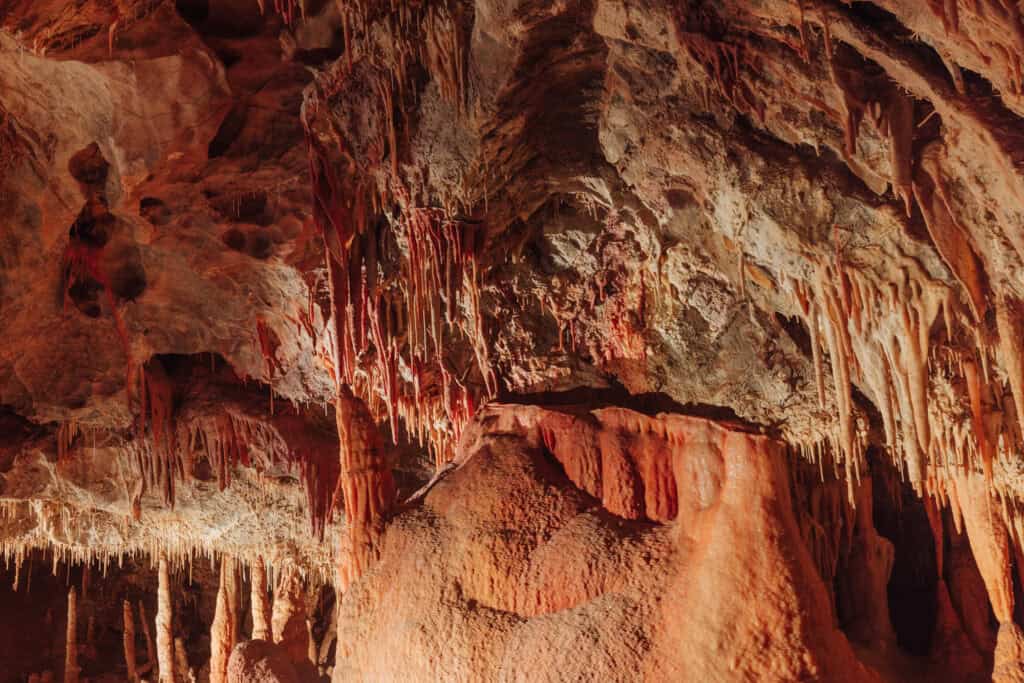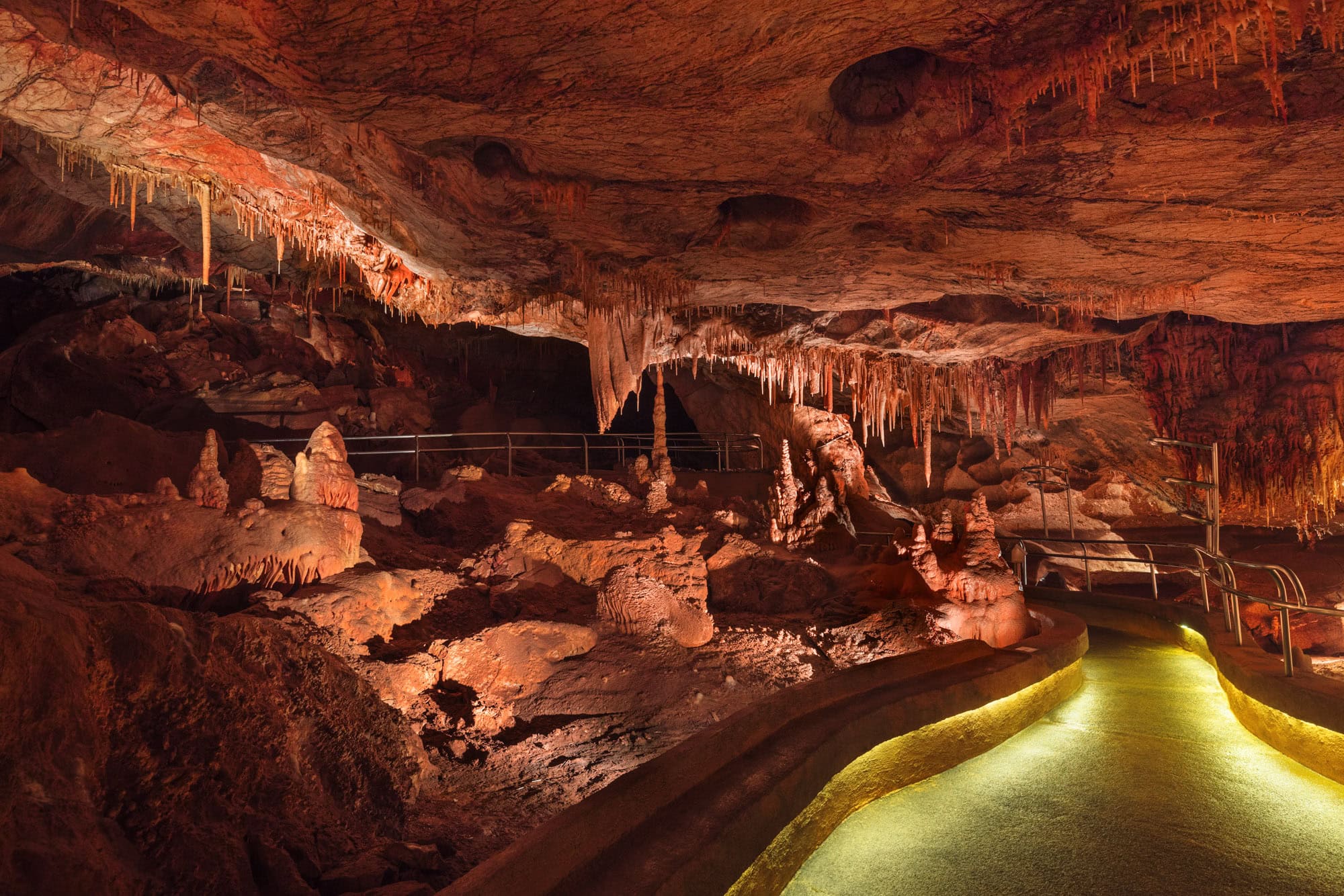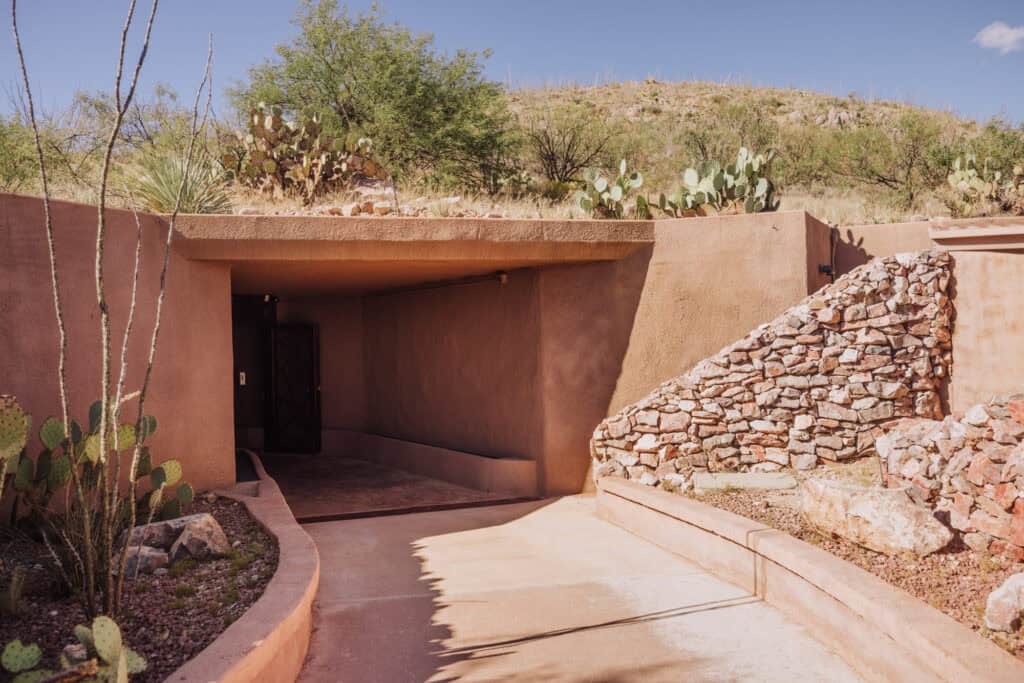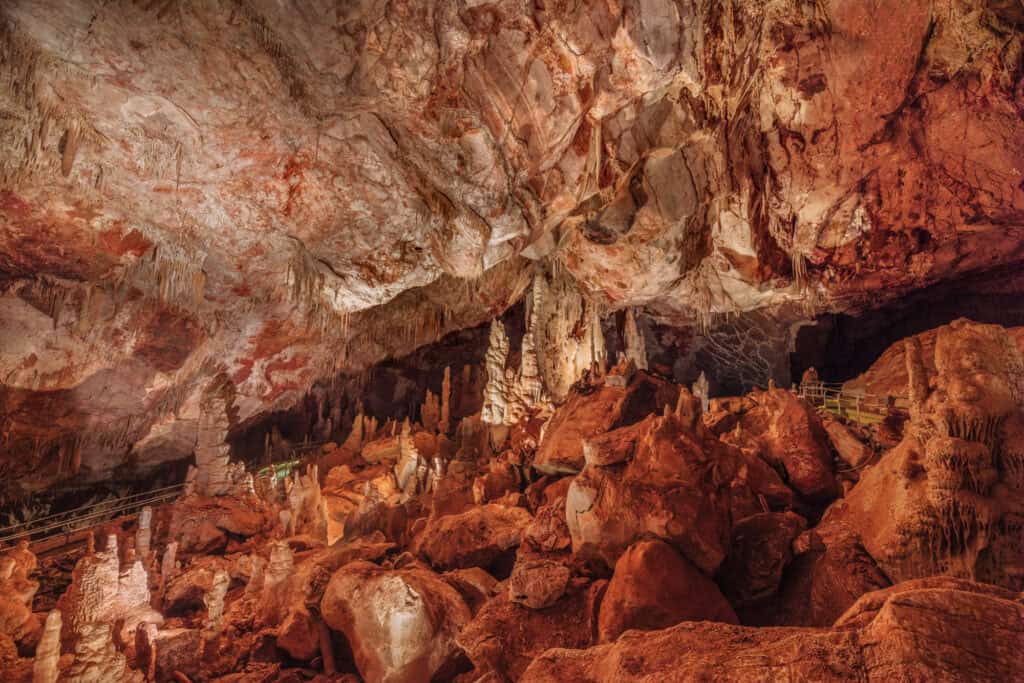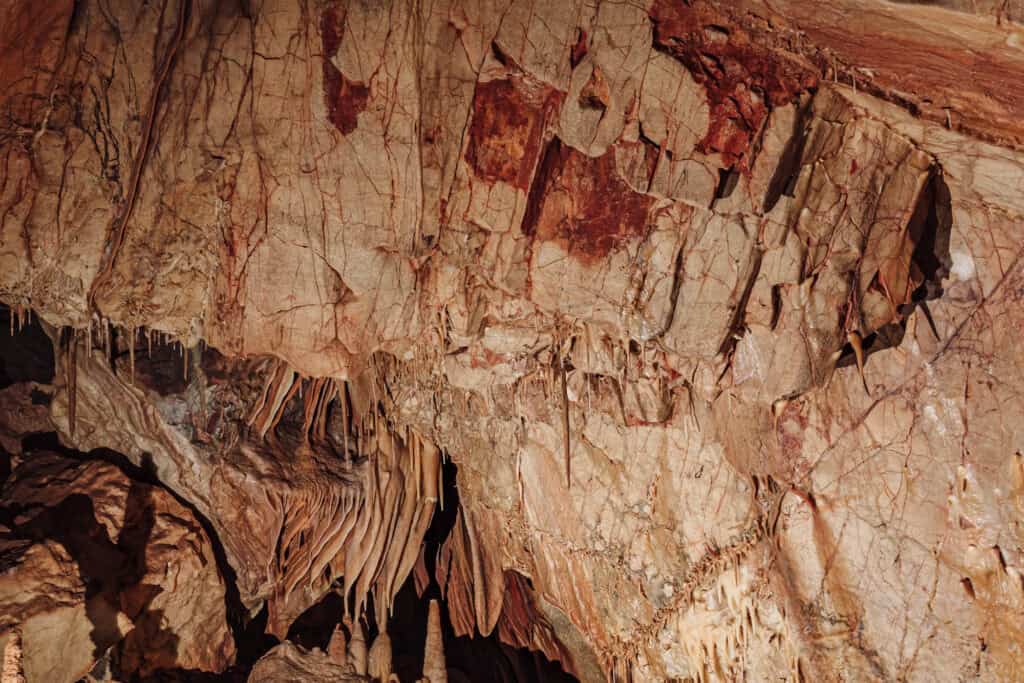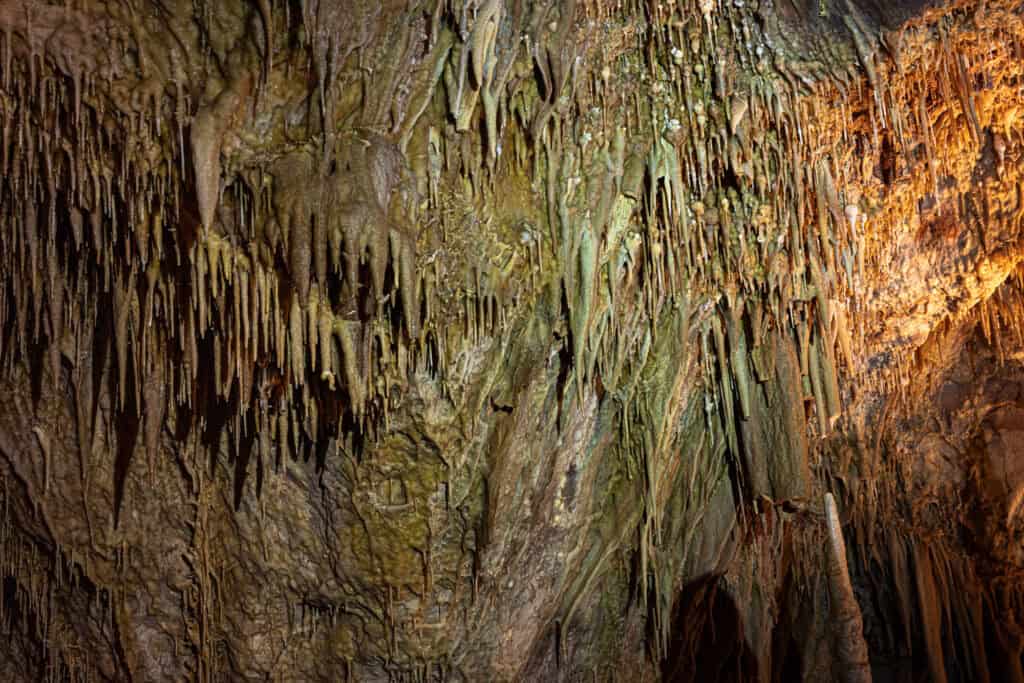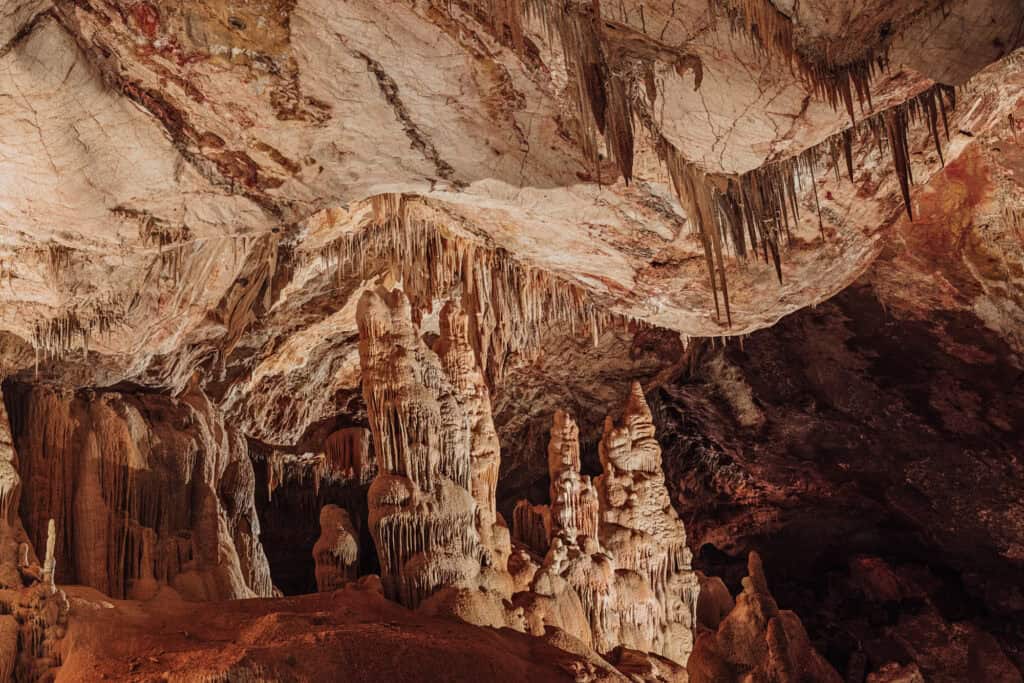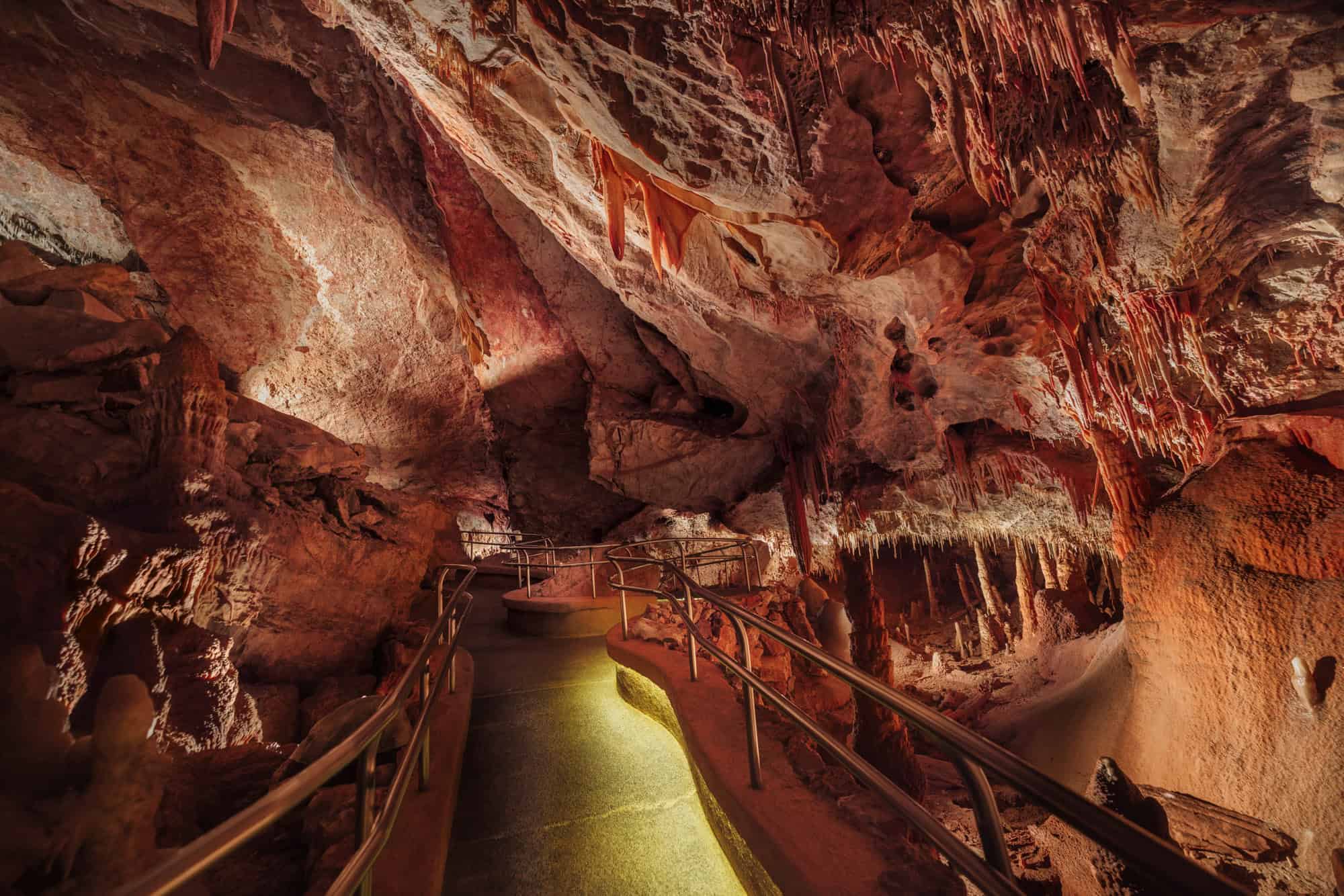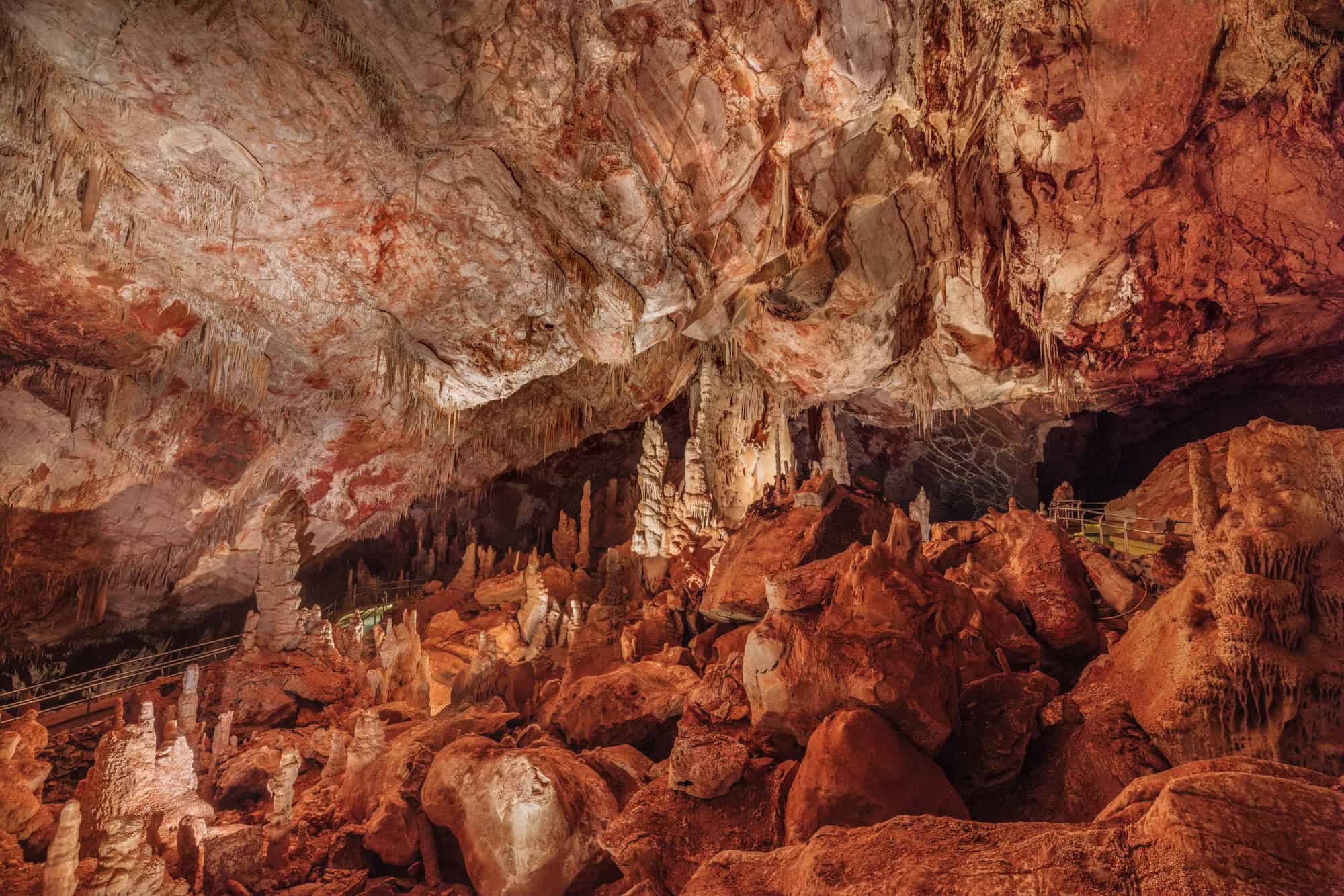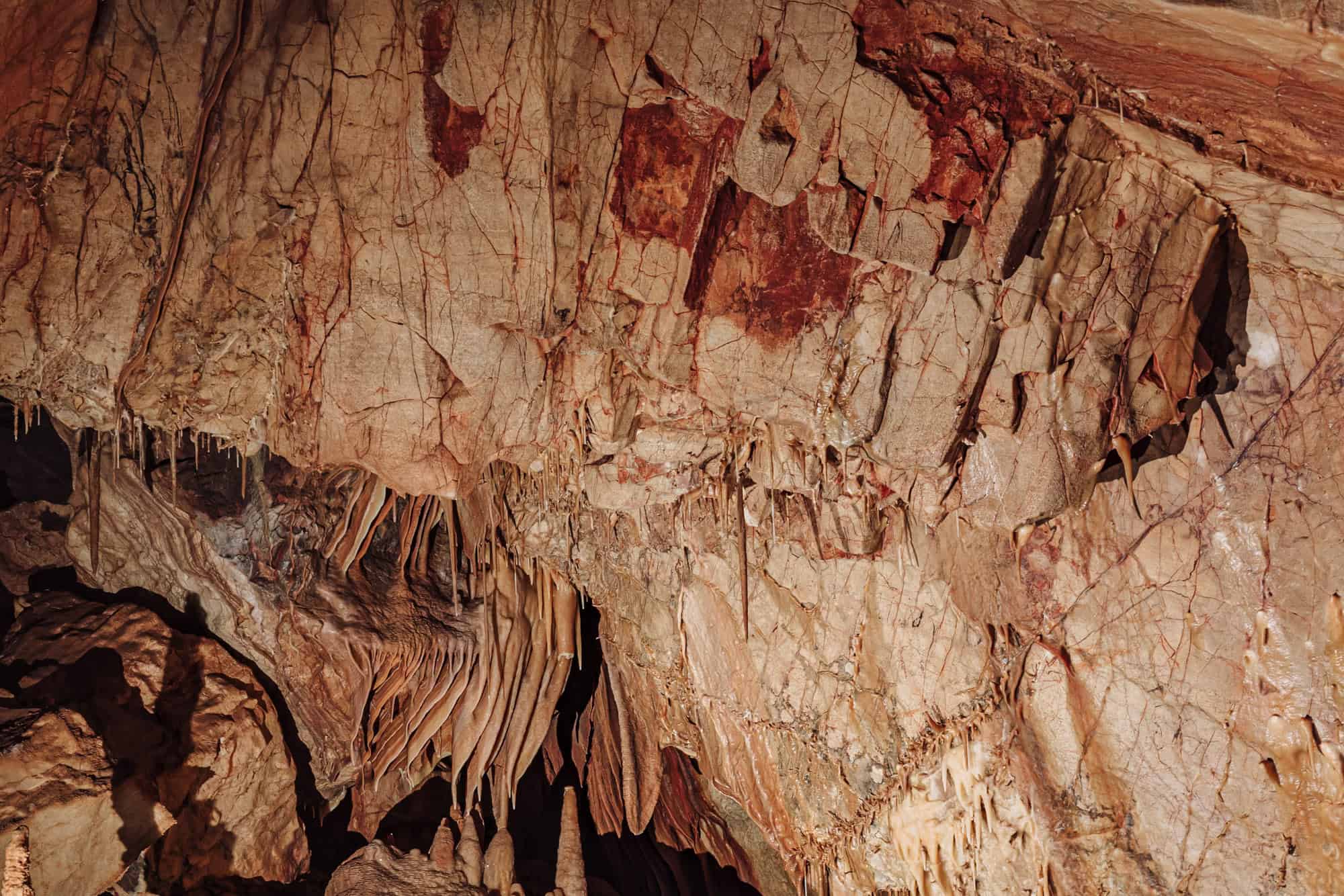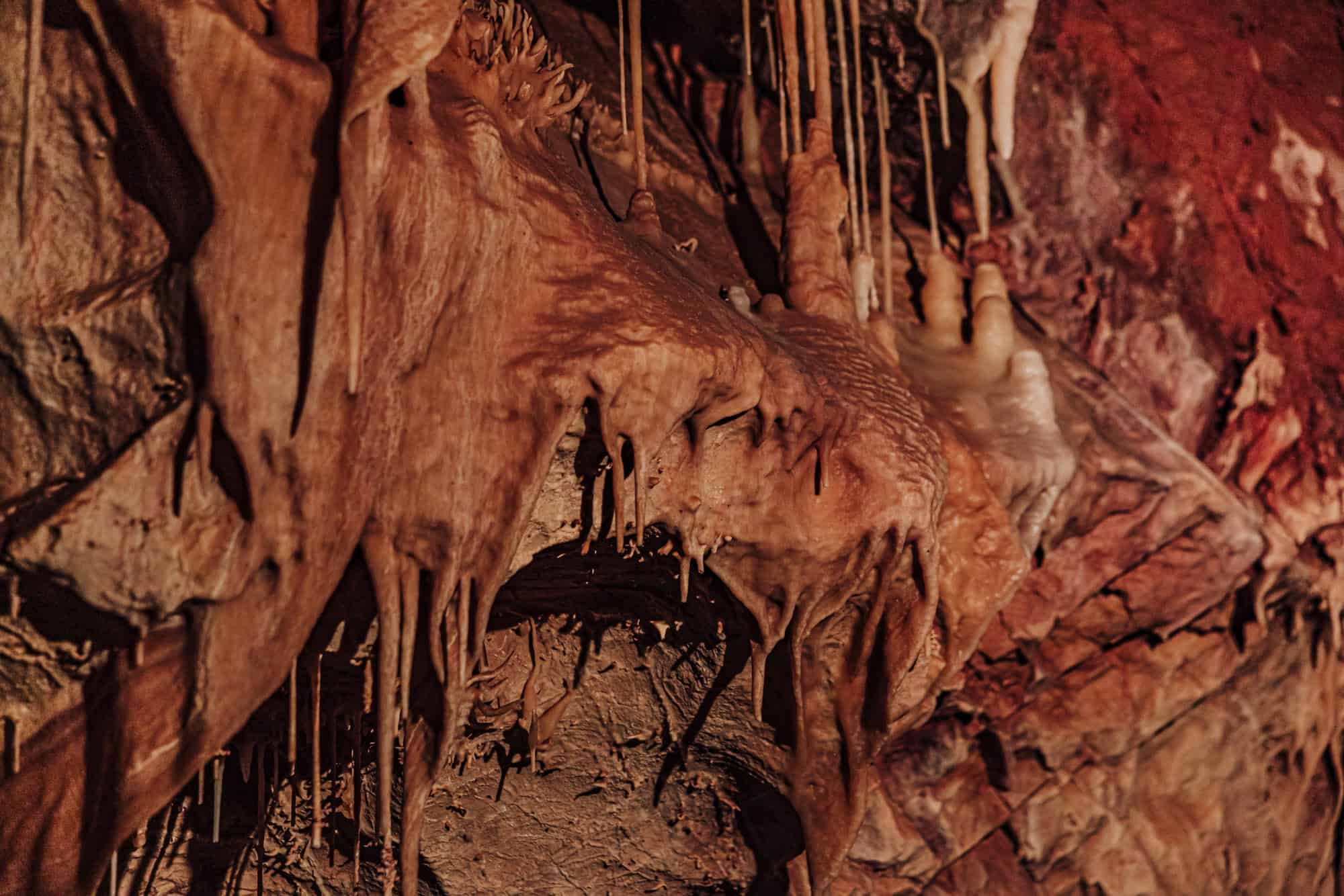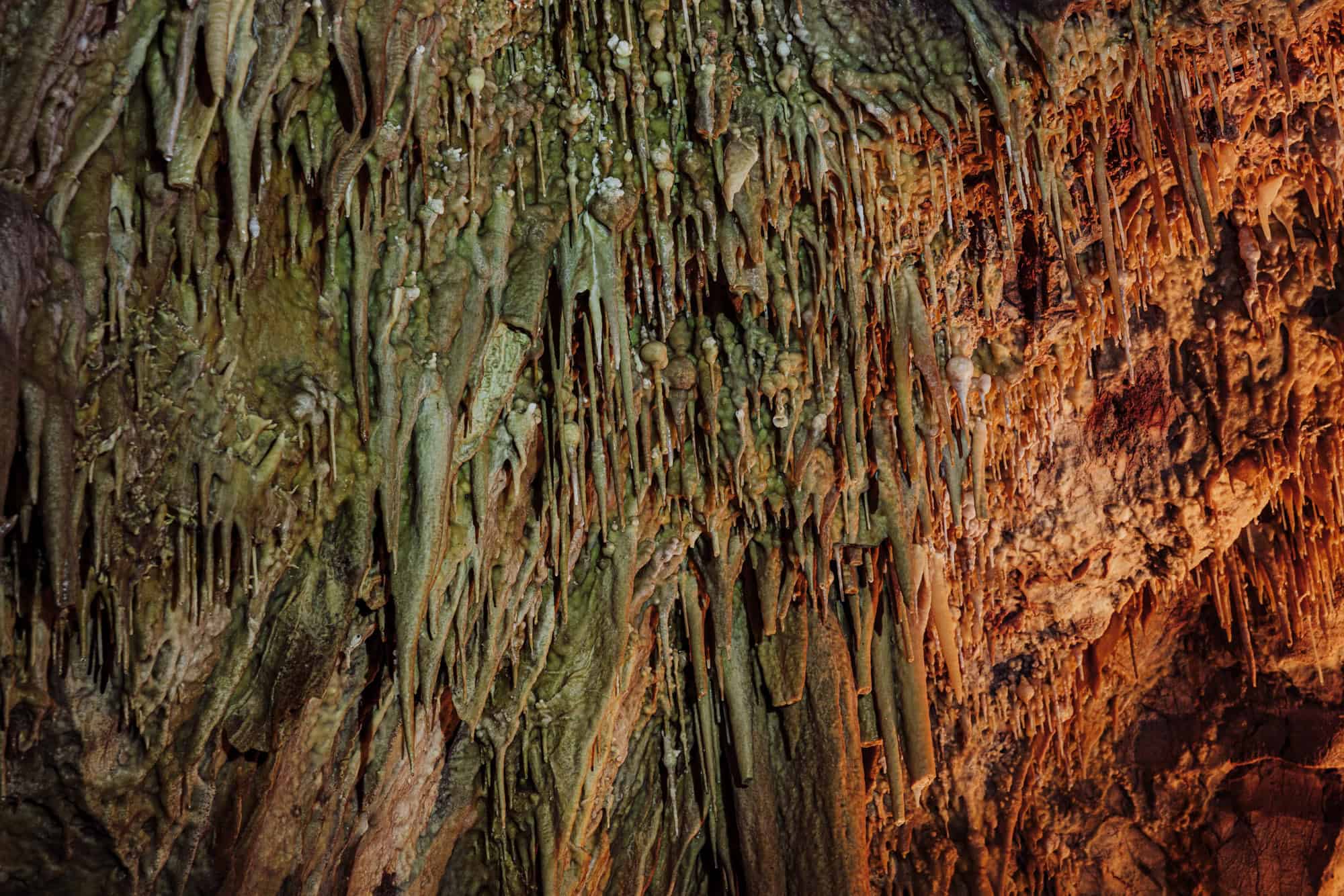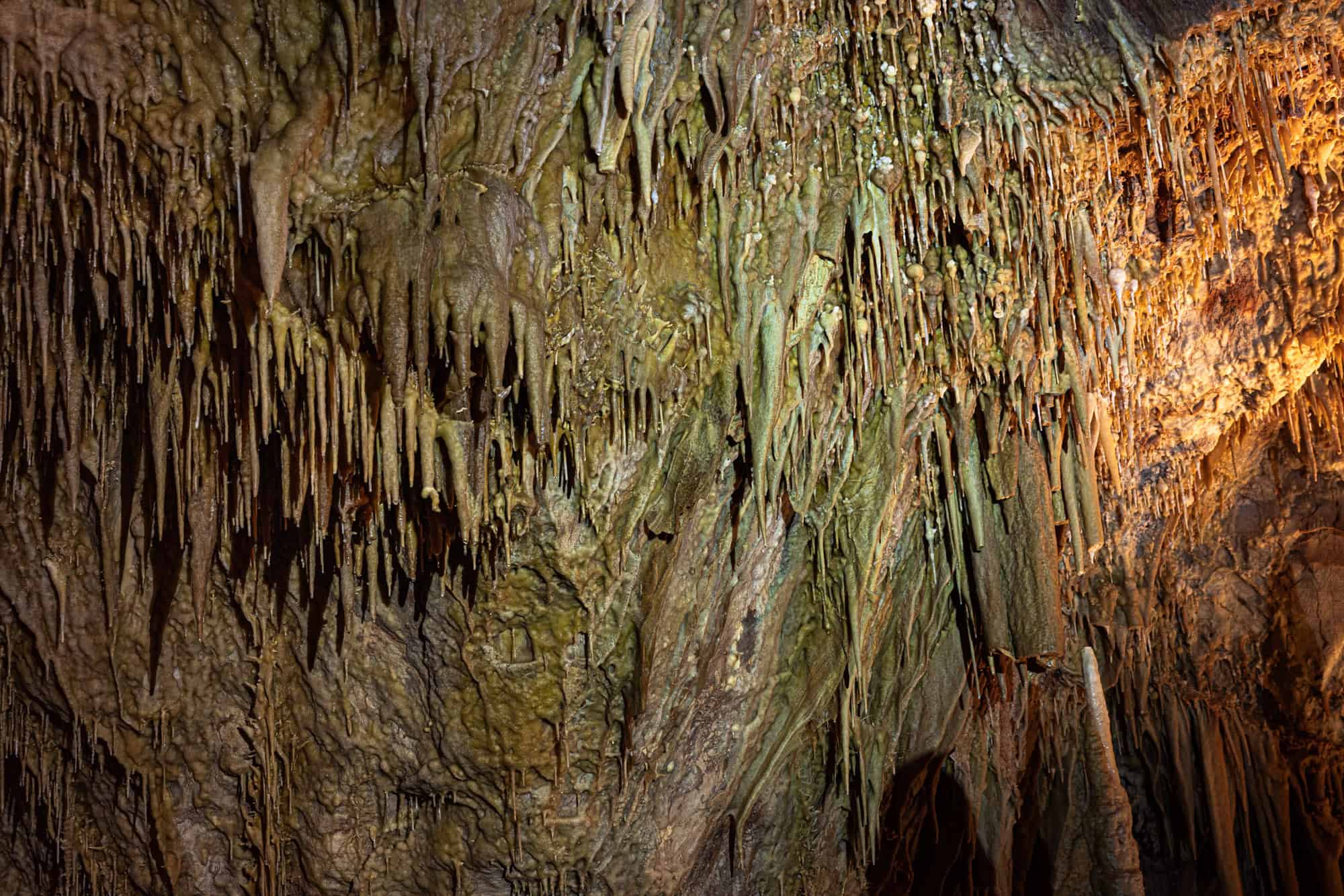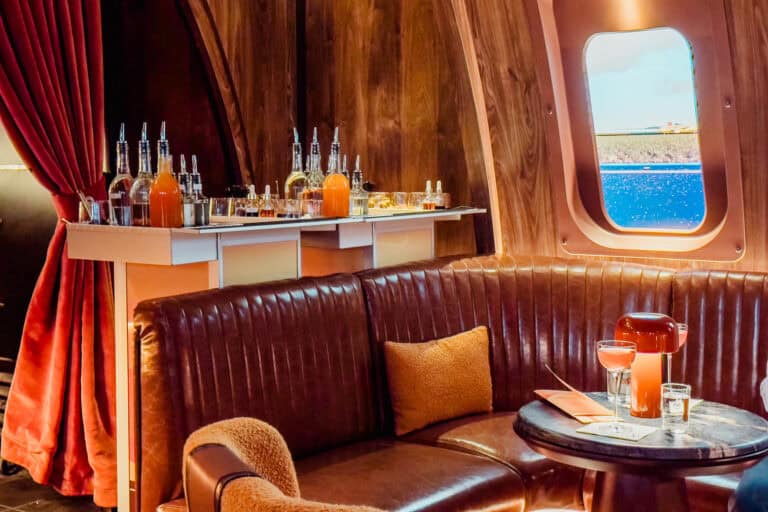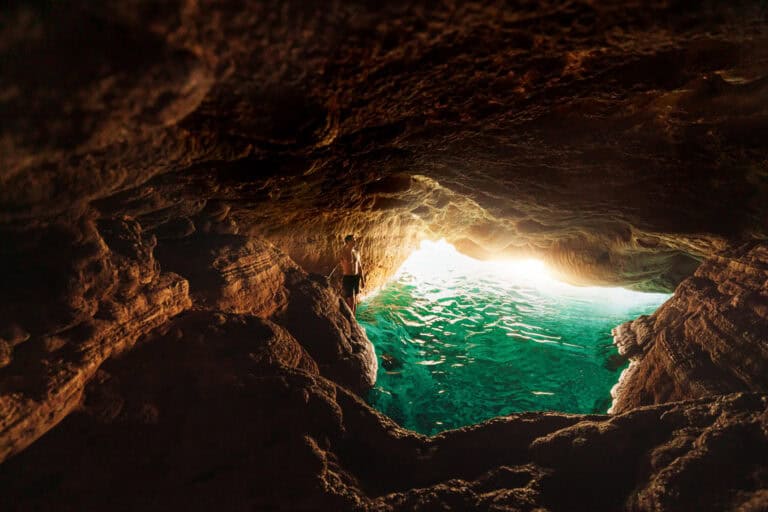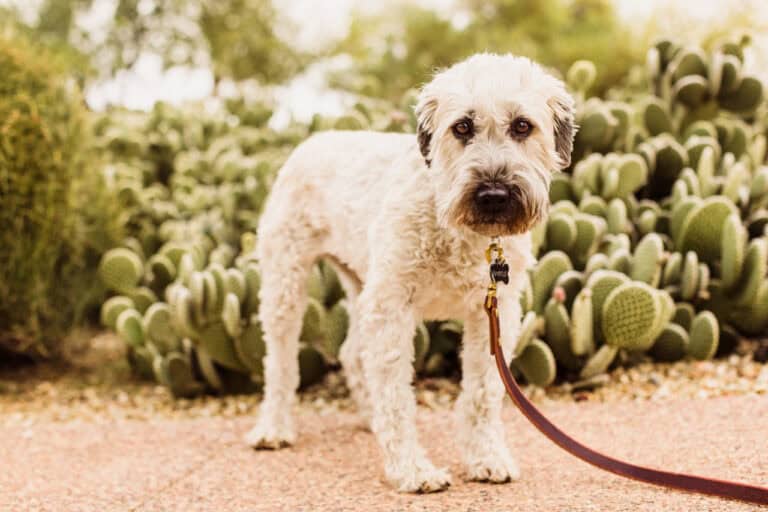Kartchner Caverns State Park: Arizona’s Once-Secret Caves

Kartchner Caverns is a relatively new discovery, which was kept secret for decades before eventually turning into an Arizona State Park.
In addition to the stunning rock formations, Kartchner is known for its focus on preservation and scientific research.
Key Info on Visiting Kartchner Caverns:
- Location: 50 miles southeast of Tucson
- You can’t explore on your own
- No photos or cameras inside
- Tour costs begin at $23
- It’s a “living cave,” so you’ll witness water drops continue to create new formations

Inside the Caverns
It’s warm and humid inside Kartchner Caverns year-round. The temperature is a pretty constant 70 degrees, and you’ll notice the high humidity, around 98%, right away.
You can feel the change as you go from the (normally) dry desert air outside through a series of air locks to seal in the humidity.

Helictites
Kartchner Caverns is known for its abundance of helictites. Unlike other formations that grow in predictable patterns, helictites defy gravity with their twisted, branching shapes that seem to grow in random directions.
Cave Bacon
The nickname “cave bacon” is given to thin, ribbon-like formations, created by mineral-rich water, flowing down slanted surfaces. As it evaporates, the minerals left behind build up. Trace amounts of iron help create the reddish brown bands and the appearance of striped “bacon.”
In some spots, cave bacon is semi-translucent. Light hitting or passing through illuminates it nicely for visitors.
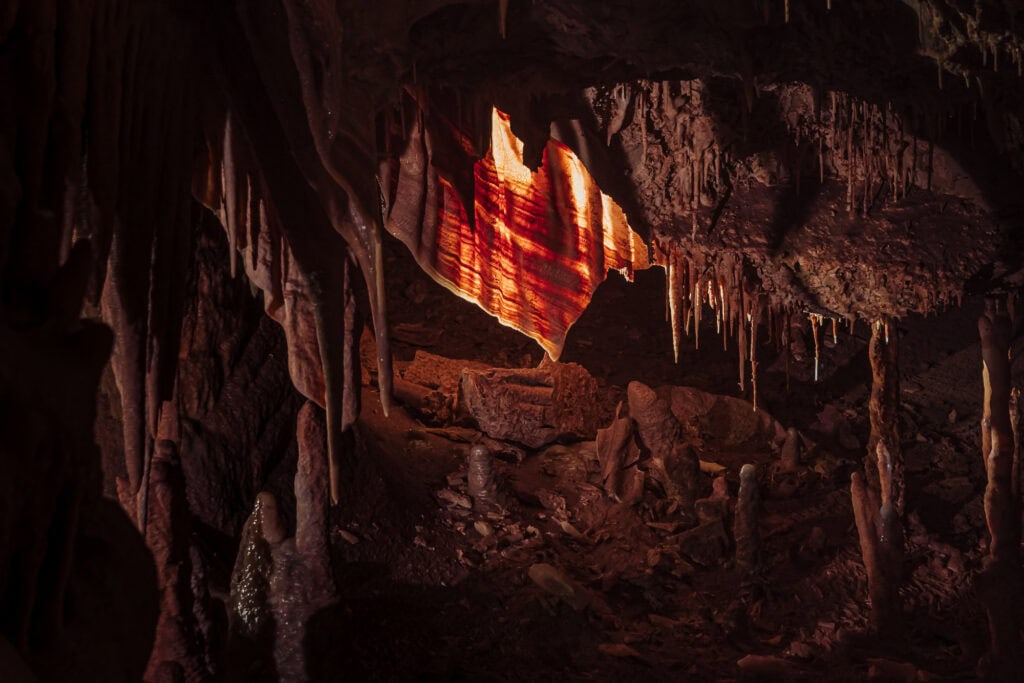
To go with the “bacon,” they have other formations which look like egg yolks frying.
Strawberry Formations
Continuing with the food theme, iron and other minerals create a pink hue in some of the formations, giving them the “strawberry” nickname.
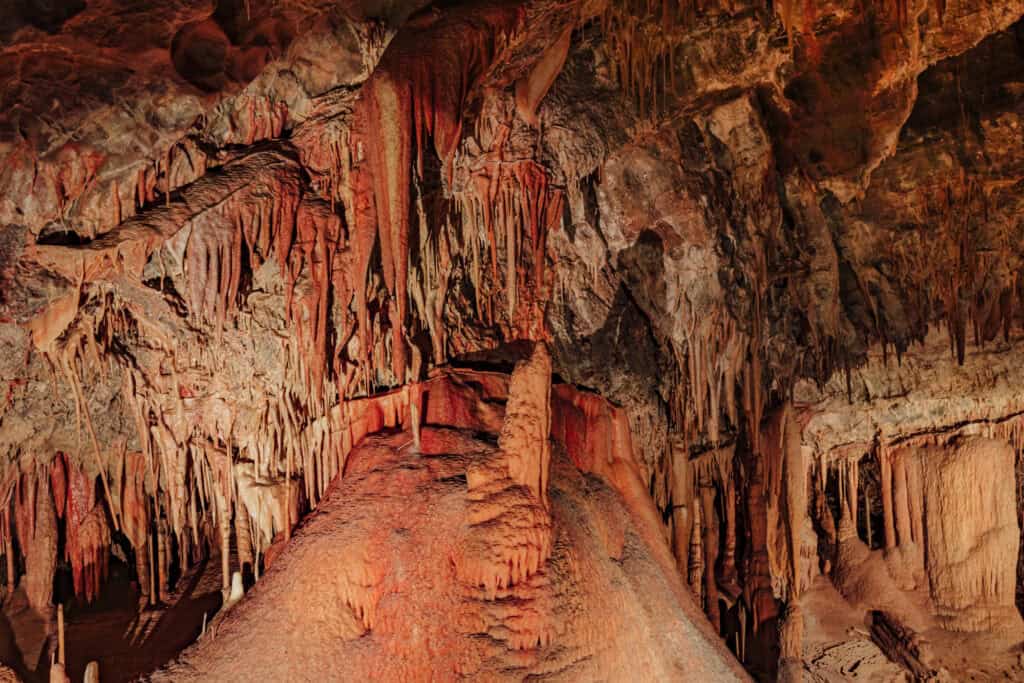
Soda Straws
The soda straw formations in Kartchner Caverns are thin, hollow stalactites that hang from the ceiling and resemble drinking straws.
They’re formed by water seeping through cracks in the cave ceilings. Traces of calcium carbonate in each drop are left behind as water drips off the tip of the straw.
In some spots, you can look inside the hollow tube. They’re thin and delicate, but can grow to a few feet if left alone. Many are preserved nicely in the ceilings at Kartchner Caverns.

Kubla Khan Column
One of the most striking formations is the 58-foot-tall Kubla Khan column, one of the largest and most pristine cave columns in the U.S.
Visiting the State Park
You can’t visit Kartchner Caverns on your own. You’ll have to take a tour, and they offer a few different options for visitors to explore the caverns and learn about their geology and history.
It’s important to note: there are no photos allowed inside, because you’re not allowed to bring cameras or have your cellphones out. The point is to protect the fragile rock formations and ecosystem inside the cave.
The guides are specially-trained to provide insight into the formation and preservation of the caverns. I’ve met a few of them and they’re all wonderful. Chelsea (below) was overly patient with my endless questions.

➡️ Click Here for Tour Bookings
The Rotunda / Throne Room Tour
This tour is ideal for first-time visitors and highlights some of the caverns’ most impressive formations. The Rotunda Room and Throne Room are filled with massive stalactites, stalagmites, and flowstone formations.
Both options are wheelchair accessible, as you’ll follow a smooth, paved pathway.
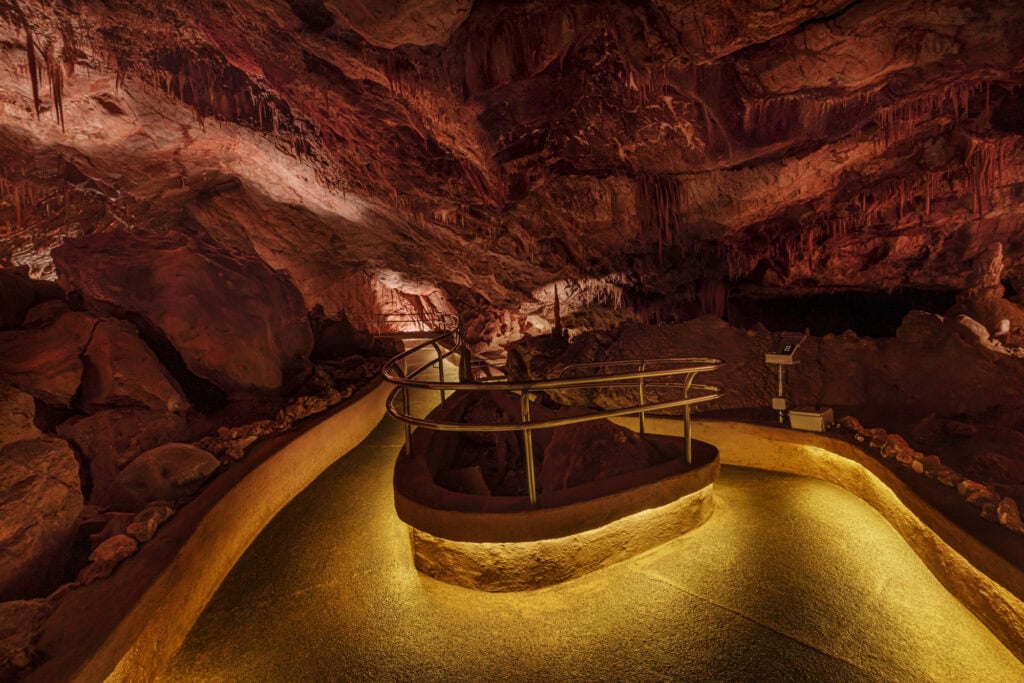
The Throne Room Tour’s highlight is the “Kubla Khan,” a spectacular 58-foot-tall column formation.
- Tour Duration: About 1.5 hours
- Availability: Year-round, several times a day
- Cost: $23
- Ages: All
- Accessibility: Wheelchair Accessible
Big Room Tour
The Big Room Tour explores the largest chamber in the cave, featuring unique formations like “cave bacon” and “soda straws.”
The Big Room is closed from late spring to early fall because the bats move in! The female bats fly in, and use the caverns for roosting and to raise their babies.
- Tour Duration: About 1.75 hours
- Availability: Mid-October through mid-April
- Cost: $23
- Ages: No children under 7
- Accessibility: Wheelchair accessible

Helmet & Headlamp Tour
This is a more immersive experience, which takes visitors into less-developed areas of the cave. You’ll wear helmets and headlamps to explore the caverns in a natural, low-light setting, similar to what the original explorers might have experienced.
- Tour Duration: 2 hours
- Availability: Limited and seasonal
- Cost: $30
- Ages: 10 and above
Photo Tour
These are longer tours, available once a month (the third Saturday of every month). It’s for amateur and professional photographers, but the photos aren’t for commercial use.
- Cost: $125
- Ages: 18 and above
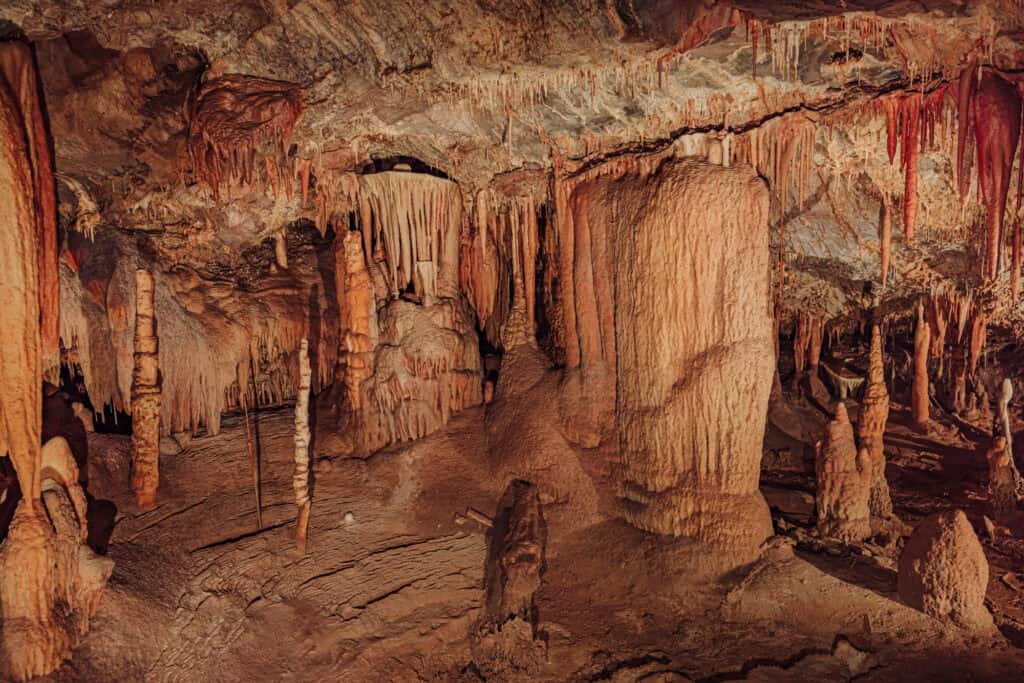
Tour Costs
Since you may be wondering why this Arizona State Park charges fees, I thought it was important to note: the state parks don’t receive money from the general fund or taxes. They’re all self-sustaining.
Tour Rules
- Bags, cameras, cellphones, backpacks, water bottles, strollers, and most other things are not allowed inside the cave. They have lockers for storage.
- Arrive 30 minutes prior to your tour departure.
- No pets are allowed on site.
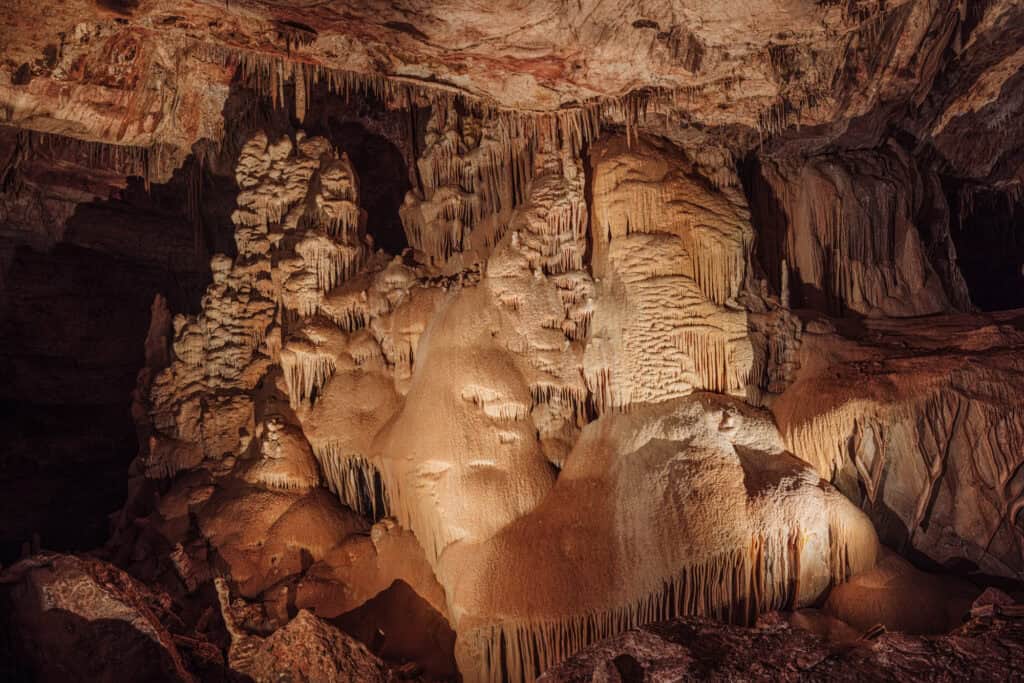
The Bats in the Caverns
The bats at Kartchner Caverns are a vital part of the cave’s ecosystem. They move in right on schedule each spring, and stay through the summer into early-fall giving birth and raising their young.
Key Facts about the Bats at Kartchner Caverns
- Species: The primary bat species found here is the Myotis velifer, a medium-sized bat known for its velvety fur.
- Maternity Colony: Each bat typically giving birth to a single pup.
- Seasonal Cave Closures: To protect the bats, Kartchner Caverns State Park restricts access to parts of the cave from mid-April to mid-September.
- Role in the Ecosystem: The bats help control insect populations, feeding on moths and beetles.
One bat, which died in the cave 50,000 years ago is preserved and part of the calcite formations. In the first photo below, it’s tough to see, but a guide will point it out:

Fall Cleanup
You can imagine: the bats leave plenty of droppings, called guano, behind. It takes a a few weeks to clean the part of the cavern they roost in before it can reopen to tours.
Bat Poop Science
Researchers found thick layers of fossilized bat guano dating back tens of thousands of years. These deposits reveal that bats have been using the cave for millennia. Studying the guano has provided insights into the cave’s ancient climate, bat populations, and even local flora and fauna from long ago.
Discovery & Foundation of Kartchner Caverns
Kartchner Caverns remains one of the most significant cave discoveries in the United States, and the story involves a mix of curiosity, secrecy, and conservation.
It’s a relatively recent discovery!
In 1974, two young cavers, Randy Tufts and Gary Tenen, stumbled upon a hidden entrance while exploring the Whetstone Mountains in southeastern Arizona. They squeezed through a narrow passage and found themselves in an extensive, underground world filled with stunning formations.
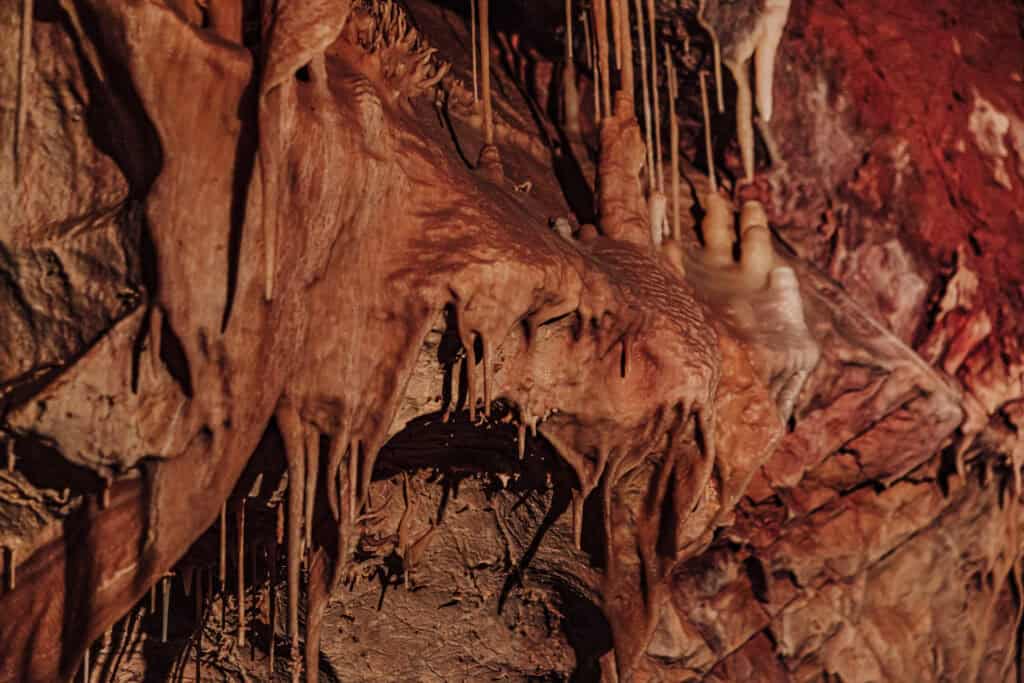
Realizing the importance of preserving this untouched environment, Tufts and Tenen kept the discovery a secret for more than a decade. They meticulously documented and mapped the cave but didn’t tell anyone outside of a trusted few.
In the 1980s, they approached the Kartchner family, who owned the land, and eventually worked with Arizona State Parks to ensure the caves would be protected. By 1988, the state of Arizona purchased the land from the Kartchner family and designated it as a state park.
Over the next decade, extensive work was done to ensure that the cave could be opened to the public without compromising its natural formations. The park officially opened to visitors in 1999, allowing people to experience the beauty of the caverns while benefiting from the conservation measures designed to preserve its wonders for future generations.
Visitors taking the tram toward this nondescript desert mountain will be stunned by what lies beneath the surface!
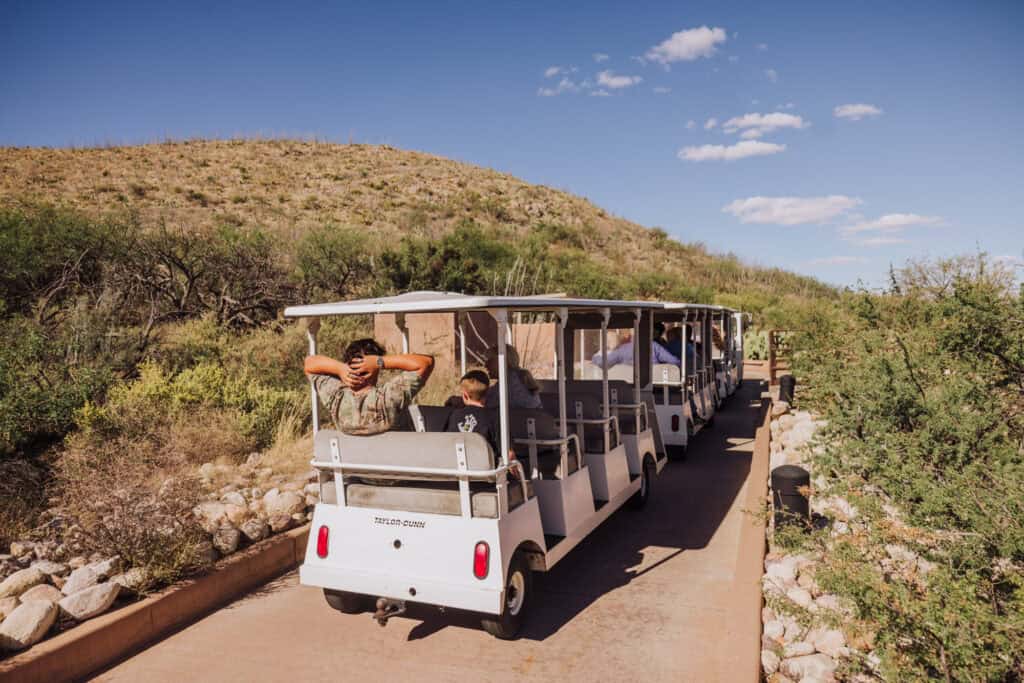
Weird & Mysterious Discoveries in the Caverns
Exploration of Kartchner Caverns has revealed fascinating and unusual discoveries.
Sloth
Bones of ancient creatures, including those of a Shasta ground sloth, were discovered inside the caverns. The remains are thought to be thousands of years old, and they indicate that prehistoric animals may have stumbled into the cave and perished.
Horse
The remains of a horse, also found in the caverns, are a bit of a mystery. It’s unknown whether it fell into the cave at one point, or whether a flood or something washed it into the underground cavern.
Bat Frozen in Time
I mentioned the ancient bat, which died and remains preserved to this day. There are likely many of these, but this one you’ll see on the Big Room Tour.

Ongoing Research
I mentioned how warm and humid it is inside Kartchner Caverns. The conditions allow for a rich microbial environment to thrive, and open the door to many kinds of scientific research.
Kartchner Caverns is considered a “living” cave, meaning that formations are still actively growing due to the continuous presence of dripping water and minerals. This ongoing development is rare in show caves, many of which are dry and no longer grow formations. This makes Kartchner a unique place to observe active cave geology in action.
On a visit, you’re likely to see staff members collecting water samples from spots like this “egg yolk” formation.
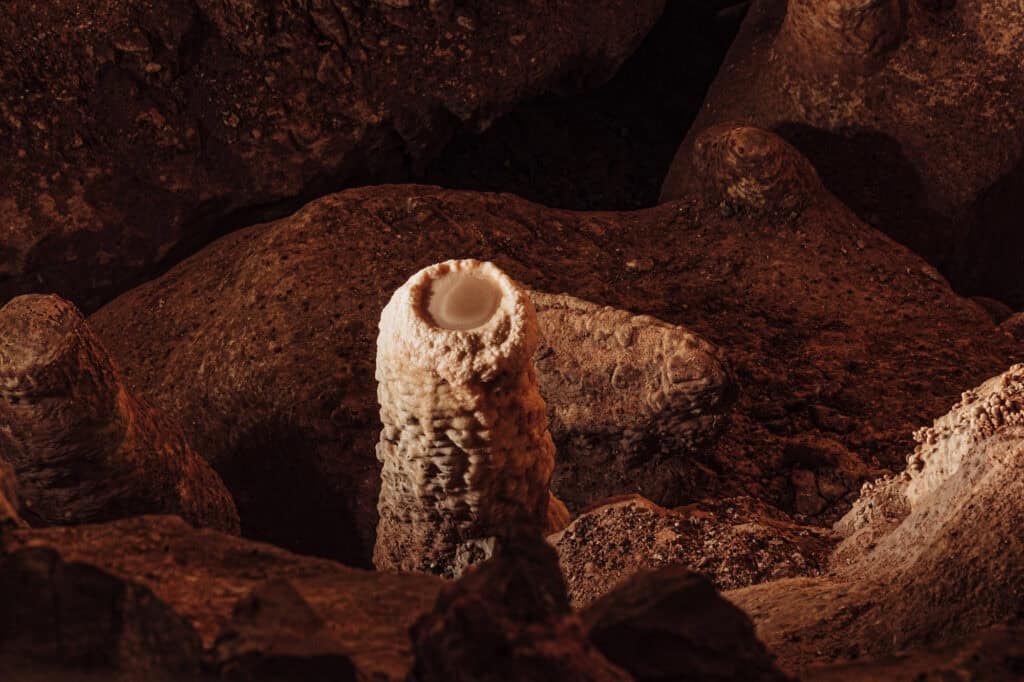
Other times, the researchers and staff will go crawling through small openings to explore parts of the caverns which are off-limits to the public.
Of the 2.5 miles of caverns underground at Kartchner, only about a mile of the cave system is open to the public.
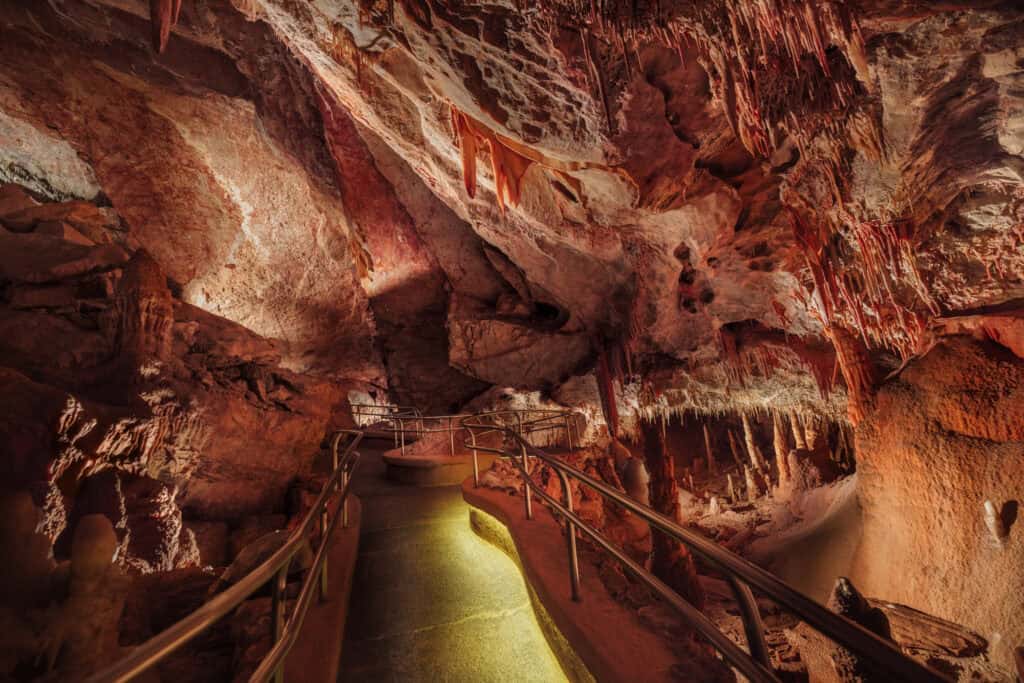
Cabins and Camping at Kartchner Caverns
Staying overnight at Kartchner Caverns State Park is a great way to experience the caves and night skies of southern Arizona. Reservations are recommended, especially for cabins and RV sites.
➡️ Click for Camping Reservations & Info
The park has a small selection of cabins equipped with basic amenities (electricity, heating and air conditioning, a table, chairs, and beds. Each accommodates six people, so they’re great options for families.
The park has several RV campsites with electric and water hookups, as well as some with sewer hookups. The sites accommodate most RV sizes, providing a comfortable option for campers on wheels.
Tent campers are also welcome.
The cabins and campsites have access to restroom and shower facilities.
Other Arizona State Parks
Arizona has 34 state parks. Here are a few of my favorites.
Tonto Natural Bridge
Tonto Natural Bridge is a natural limestone bridge near Payson, AZ. It spans 183 feet across the canyon, making it one of the largest natural bridges in the world.
The bridge was formed over thousands of years by erosion, with a stream running through the tunnel-like structure. Visitors can hike to various viewpoints and explore the area under the bridge.
Tombstone Courthouse
Tombstone Courthouse State Park, in Tombstone, Arizona, preserves the historic Cochise County Courthouse, which was the center of law and order during the late 1800s in the Wild West. The courthouse, built in 1882, is a museum today, offering exhibits on the town’s history, including its famous gunfight at the O.K. Corral.
Picacho Peak
Picacho Peak is a landmark mountain located off the Interstate 10 between Phoenix and Tucson in central Arizona. Its distinctive, steep peak rises 1,500 feet above the surrounding desert landscape.
A challenging leads to the summit with panoramic views of the Sonoran Desert.
The area is also historically significant, as it was the site of the Civil War’s westernmost battle in 1862.
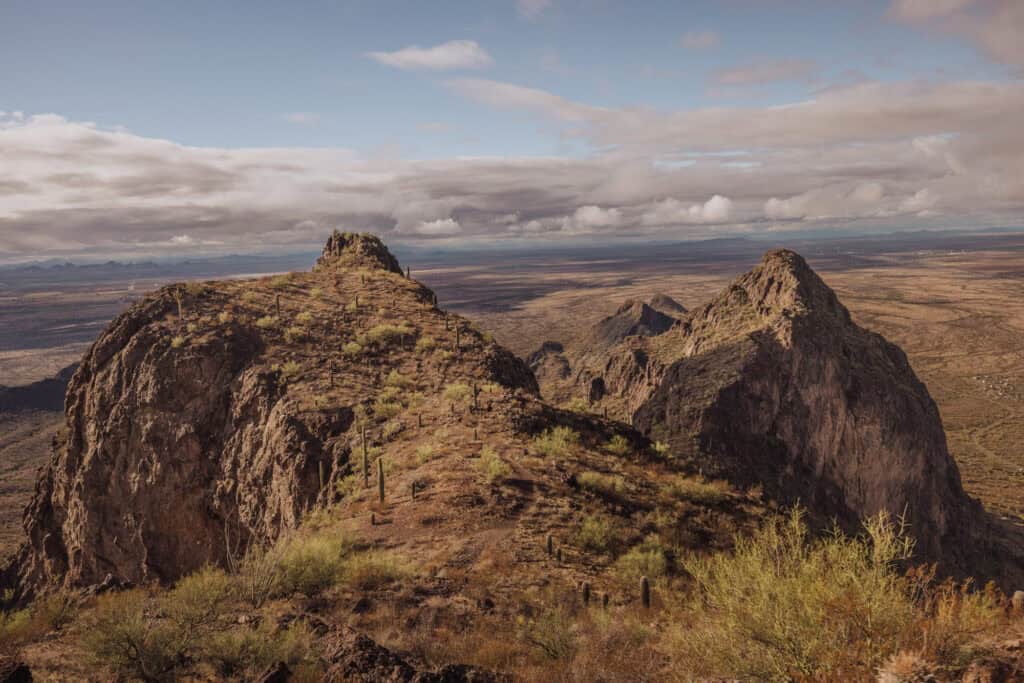
Roper Lake
Roper Lake State Park, near Safford in Eastern Arizona, offers a peaceful desert fishing experience. It also features a campground and cabins to rent.
Another nearby state park, Dankworth Pond, is also known to be well-stocked for fishermen.
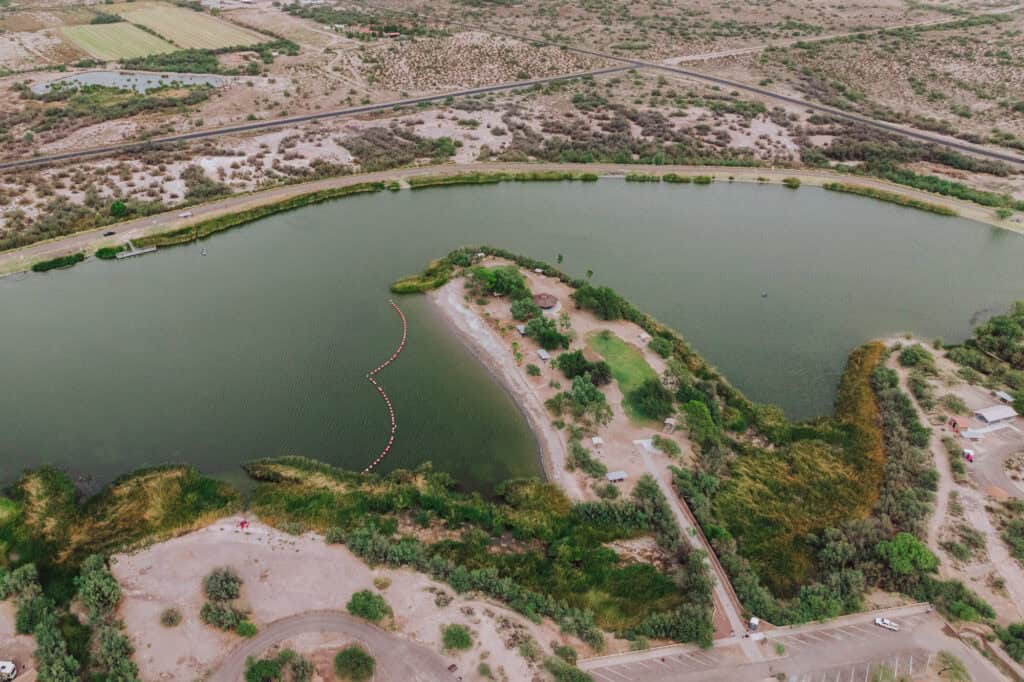
Saguaro National Park
While a National Park, I’m including Saguaro National Park as another option to visit in southern Arizona. It’s split into two halves, on either side of Tucson. The park is home to petroglyphs and hiking trails, which lead through two million giant saguaro cacti in the Sonoran Desert.
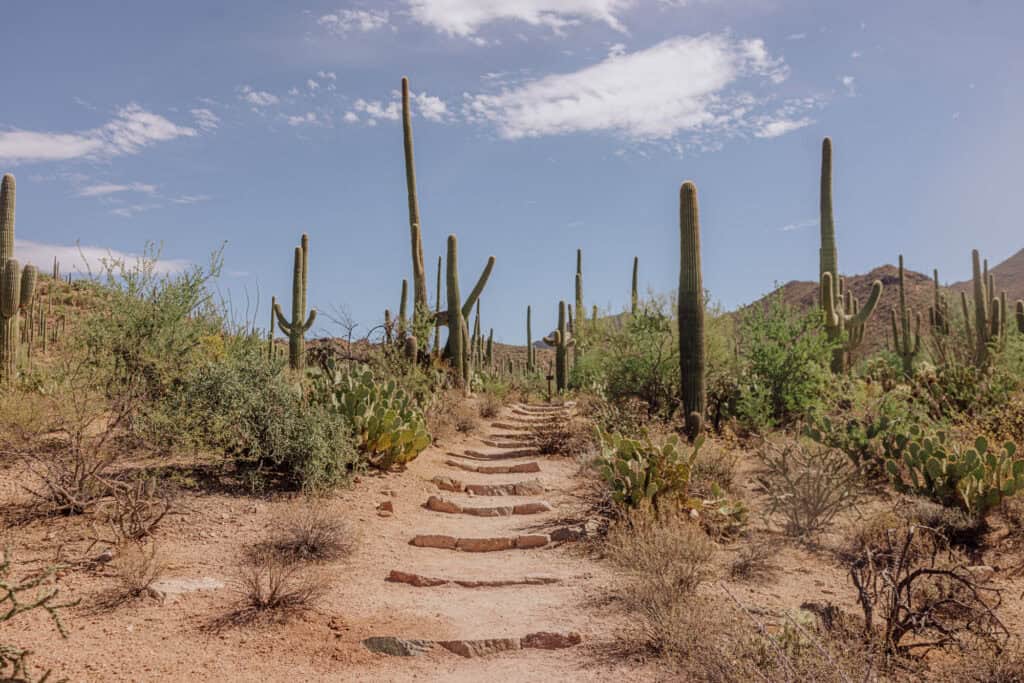
More Sites in Southern Arizona
If you’re driving around Southern Arizona, consider making a stop at some of these iconic destinations:
- San Xavier Mission
- Chiricahua National Monument
- The wineries in Sonoita & Elgin, including Dos Cabezas, Los Milics, and Rune Wineworks
- Bisbee
- The town of Lowell, AZ (near Bisbee)
- Tombstone
Kartchner Caverns or Colossal Cave?
Colossal Cave is another well-known cavern near Tucson with stunning formations. It offers a different experience from Kartchner:
- Kartchner Caverns is “living,” meaning it’s still active and growing, while Colossal Cave is dry without a water source.
- Colossal Cave was discovered decades earlier, in the 1920s. It was quickly opened to tourists and has been accessible to the public for a century.
- While extensive conservation measures are preserving Kartchner Caverns’ ecosystem, Colossal Cave has fewer controls.
Each cave provides a unique perspective on Arizona’s underground landscapes.
While you can’t take photos inside Kartchner Caverns, the experience is more interesting to me because of the ongoing scientific research. Plus, the public tours are relatively new. The Rotunda/Throne Room Tour opened to the public in 1999, while the Big Room didn’t open until 2003.
